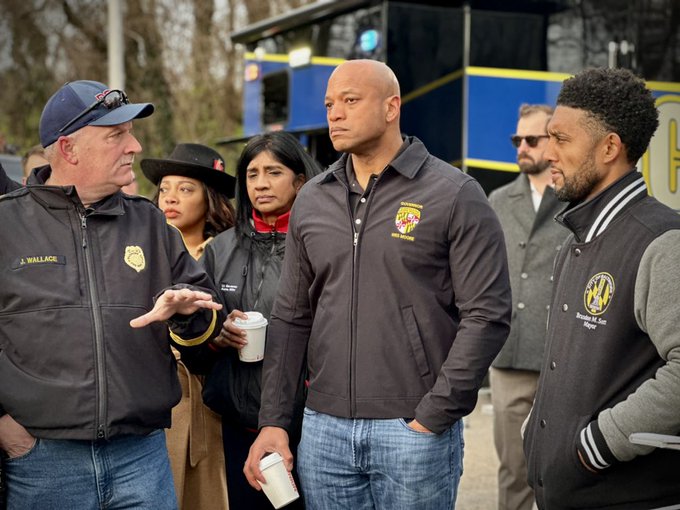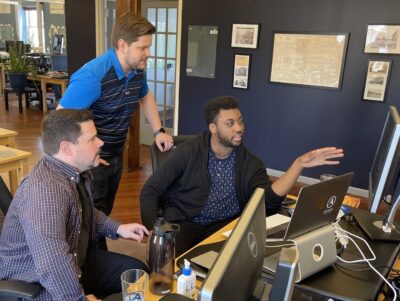Early Tuesday morning, a container ship collided the Francis Scott Key Bridge, which carries I-695 over the Patapsco River near the Port of Baltimore. The bridge collapsed in what was perhaps Maryland’s worst civil engineering disaster in recent memory.
Local, state and federal agencies have been coordinating resources and rescue efforts in the aftermath.
Details continue to emerge as the Baltimore City Fire Department, Maryland Governor’s Office, Baltimore Mayor’s Office, Baltimore County Government, US Department of Transportation and other government entities work to determine exactly what happened.
What went wrong? How many people are affected? Could this have been prevented? As the situation unfolds, here’s what we know so far. We’ll keep this story updated as new information comes forth.
The bridge’s collapse
At about 1:30 a.m. ET on March 26 the Singapore-registered cargo ship Dali collided with a beam supporting the Key Bridge. Although the reasons for the crash remain unclear, the ship reported losing power just before it happened.
The mayday call helped authorities reduce some of the vehicle traffic on the bridge at the time, Gov. Wes Moore told the Associated Press.
ABC News cited a report from the federal Cybersecurity and Infrastructure Agency that said the ship “lost propulsion” and noted the ship’s crew had told the Maryland Department of Transportation that they had lost control and risked a possible collision. The Dali ultimately struck one of the bridge’s main support beams, which sent much of the structure crumbling into the Patapsco.
The Dali was apparently involved in a 2016 crash in Antwerp, Belgium, as well; according to The Guardian, the ship was detained after its bow swung around and scraped along the side of a quay.
Video of the collapse was captured by the StreamTime Live YouTube channel, which maintains livestreams of various scenes.
The bridge, which was completed in 1977, offers an entry point to the Port of Baltimore, the country’s largest for specialized cargo. Federal data noted that the bridge was certified with a “fair” rating in 2021, according to the WSJ.
Search and rescue efforts underway
All 22 members of the ship’s Indian crew were accounted for, according to a statement from the Dali’s technical manager Synergy Marine Group.
In the meantime, at least two people have been rescued in the collapse’s aftermath, with one being hospitalized and later discharged, according to The Baltimore Banner and CNN. The construction workers were employed by the Hunt Valley-based contractor Brawner Builders Inc., according to The Washington Post. The company’s executive vice president Jeffrey Pritzker said that six of those workers were presumed dead, with another hospitalized, according to the Associated Press (AP). The AP also said that officers were just about to notify the construction workers about the impending disaster, but couldn’t before the ship hit the support beam.
Baltimore City Fire Department Director of Communications Kevin Cartwright said that the collapse was a “developing mass casualty event,” the AP additionally reported.
Gov. Moore and Baltimore Mayor Brandon Scott each announced a state of emergency Tuesday morning.
“Our teams are mobilizing resources and working swiftly to address this crisis and ensure the safety and well-being of our community,” Mayor Scott wrote in an X post accompanying his office’s emergency declaration.
“My office is in close communication with US Transportation Secretary Pete Buttigieg, Baltimore Mayor Brandon Scott, Baltimore County Executive Johnny Olszewski, and the Baltimore Fire Department as emergency personnel are on the scene following the collapse of the Francis Scott Key Bridge,” Gov. Moore said in an announcement. “I have declared a State of Emergency here in Maryland and we are working with an interagency team to quickly deploy federal resources from the Biden Administration.”
Later on Tuesday afternoon, President Joe Biden pledged that the federal government would “pay the entire cost” to rebuild the Key Bridge, The New York Times reported.
Impacts on travel and commerce
As the human cost of this tragedy gets calculated, the collapse has already inflicted apparent damage on transit and commercial shipping. The Maryland Port Administration, the state agency tasked with overseeing the port, announced that all vessel traffic has been indefinitely halted.
“This does not mean the Port of Baltimore is closed,” the statement continued. “Trucks are being processed within our marine terminals.”
That said, other surrounding transit has been largely closed off. I-695’s outer and inner loops are closed at Maryland Routes 10 (Exit 2) and 157 (Exit 43), respectively, The Baltimore Sun reported. The Federal Aviation Administration also announced restrictions on drone piloting around the crash site.
Drone pilots: The FAA has flight restrictions in place around the Francis Scott Key Bridge collapse. Do not interfere with rescue operations. If you fly, emergency response operations cannot. https://t.co/AXVbkrrk82 #NoDroneZone pic.twitter.com/mRFTxw1r96
— The FAA ✈️ (@FAANews) March 26, 2024
What we don’t yet know that tech could help answer
Many questions remain around the disaster. Some of the biggest we’re hoping to answer include:
- How often are bridges like this stress-tested? Is there technology to make this testing more frequent or accurate?
- Was there a structural flaw in the design? Was the bridge en route to a collapse even without a ship crashing into a support beam?
- Does any technology exist to help ships like the Dali avoid collisions like these? What about the agencies and oversight entities responsible for making sure something like this doesn’t happen?
- Where can software platforms help avoid any component of this disaster, or assist with the recovery and rebuilding process?
- Are any local tech companies working on anything related to the collapse and its aftermath?
- How does tech, especially software, figure into and assist tracking and coordination of shipping, transit, search and rescue, or other infrastructure safety work?
As Technical.ly continues reporting on the Key Bridge collapse, we’d like to speak to any of you working on anything related to the various transit, shipping, infrastructure, engineering and other concerns reflected in this disaster. Please email baltimore@technical.ly if you wish to offer any expert commentary, or know someone who could.
Join the conversation!
Find news, events, jobs and people who share your interests on Technical.ly's open community Slack






